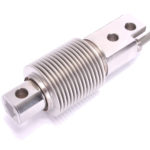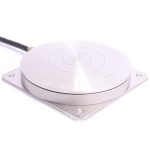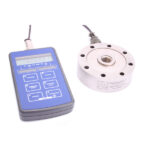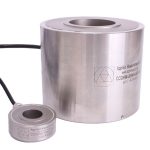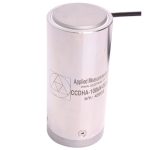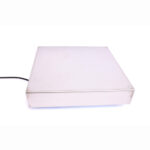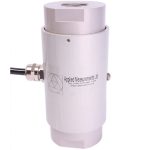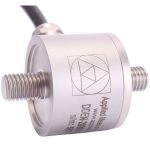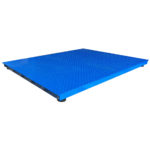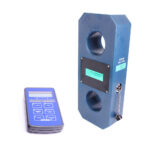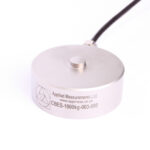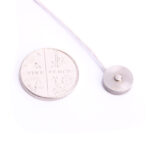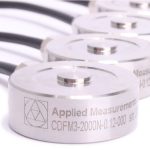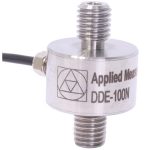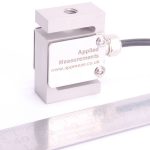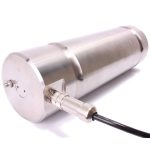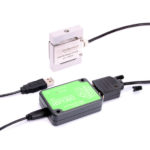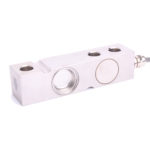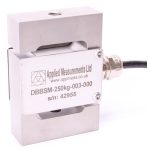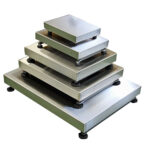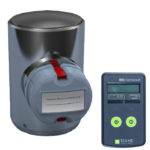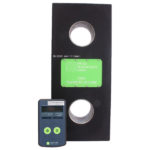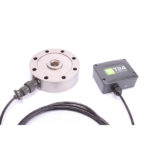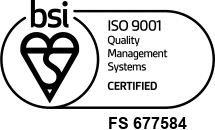Applied Measurements supply and manufacture precision load cells and force sensors. Our load cells have been used for over 30 years in all industries from aerospace, geotechnical, medical, materials testing and subsea. From R&D projects to high-volume scheduled orders, we know we can find a load-measuring system to suit you.
Our load cells are manufactured in the UK, plus we hold stock of many of our standard load cells.
If a standard load cell isn’t what you are looking for, our in-house and UK-based experts can also design & manufacture customised sensors and systems to suit your exact requirements.
Applied Measurements are ISO 9001:2015 Quality Management Certified by BSI under certificate number FS 677584 for the design, manufacture and distribution of transducers and measuring systems.
Load Cells & Force Sensors Explained
Product Links
Filters
Availability
Shape/Type
Capacity
Environment
Force/Load Direction
Bending Beam Load Cell | OBBS
0-5kg to 0-500kg
Hermetically SealedFrom £231Brake Pedal Load Cell | Accelerator Pedal Load Cell | CCGBP
0-50kg up to 0-250kgFrom £650Buy OnlineCompact S-Beam Load Cell | DBCR
0-10N up to 0-500NFrom £278Buy OnlineDome Top Column Load Cell | Canister Load Cell | CCDDT
0-2te up to 0-1000teFrom £786Donut Load Cell / Annular Load Cell | CCG
0-12.5kN up to 0-540kNFrom £621Force and Torque Sensor | 2-Axis | Bi-Directional | DBBSS/TSF
0-50N/0-1Nm up to 0-250kN/0-2500NmFrom £2,749High Accuracy Column Load Cell | 0.1% | CCDHA
0-2te up to 0-1000teFrom £920Hygienic Weighing Platform | WPSPS
0-3kg up to 0-300kgFrom £657In-Line Column Load Cell | High Capacity | DBCL
0-1te up to 0-150teFrom £973In-Line Submersible Load Cell | IP68 | Underwater Force Sensor | DDEN
0-50N up to 0-50000NFrom £502Buy OnlineIndustrial Low Cost Weighing Platform | WPX
0-150kg up to 0-3000kgFrom £604Industrial Weighing Platform | WP
0-300kg up to 0-3000kgFrom £1,505Link Load Cell | Load Monitoring Link | ET Wired
0-1te up to 0-100teFrom £1,082Link Load Cell | Load Shackle | SLC Wired
0-1te up to 0-400teFrom £1,078Low Profile Tension and Compression Load Cell | DSCRC
0-200N to 0-2000NFrom £1,176Miniature In-Line Load Cell | Tension and Compression | DDE
0-100N up to 0-50000NFrom £353Buy OnlineMiniature Load Cell with Display | DDE + INT4-L
0-100N up to 0-50kNFrom £817Buy OnlineMiniature S-Beam Load Cell | Z-Beam Force Sensor | DBBSMM
0-1kg up to 0-50kgFrom £326Buy OnlinePin Load Cell | Shear Pin Load Cell | Force Measuring Pin | DBEP
0-2.5te up to 0-50teFrom POAPlatform Load Cell | Single Point Load Cell | 0-250g to 0-40kg | OBUG
0-250g to 0-40kgFrom £128S Type Load Cell with Display | DBBSM + TR150
0-1kg up to 0-30,000kgFrom £662Buy OnlineS-Beam Load Cell USB Interface | DBBSM + DSCUSB
0-1kg up to 0-30,000kgFrom £656Buy OnlineShear Beam Load Cell | OSBST
0-500kg to 0-5000kgFrom POASingle Point Load Cell | Platform Load Cell | OBUC
0-10kg to 0-200kgFrom £160Single-Ended Shear Beam Load Cell | OSBKT
0-250kg to 0-2000kgFrom POASubmersible Load Cell for use in Triaxial Chambers | IP68 to 70bar | STALC3
0-1kN to 0-100kNFrom £699Buy OnlineSubmersible S-Beam Load Cell | IP68 Waterproof | DBBSUB
0-0.5kN up to 0-5kN
Hermetically SealedFrom £488Universal Load Cell | Universal S-Beam Force Sensor | DBBSM
0-1kg up to 0-30,000kgFrom £254Buy OnlineWeighing Platform Rectangular | WPR
0-3kg up to 0-500kgFrom £341Wireless Column Load Cell | CCDDT24
0-50te up to 0-1000teFrom £2,523Buy OnlineWireless Crane Scale | Crane Load Monitoring | ET24 Telemetry Lift Link
0-1te up to 0-500teFrom £2,501Buy OnlineWireless Load Shackle | Link Load | SLC24
0-12te up to 0-1000teFrom £2,222Z-Beam Load Cell | S-Beam Load Cell | High Accuracy | DBB
0-50kg up to 0-6,000kgFrom £222
Load Cells & Force Sensors Explained
What is a load cell?
A load cell – sometimes referred to as a ‘force’, ‘weigh’ or ‘weight’ cell – is a transducer that converts the load acting on it into a measurable (analogue or digital) output. The output is proportional to the force or load applied. Below we explain how to carry out force measurement using a strain gauge transducer and the different types of load cells and force sensors available.
Strain Gauge Load Cell Working Principle
The conversion is achieved by the physical deformation of strain gauges, which are bonded onto the load cell structure. The strain gauges are connected into a Wheatstone Bridge circuit with four strain gauges (full bridge), two gauges (half-bridge) or one gauge (quarter bridge). With half and quarter bridges, the bridge is completed using precision monitors.
Additional bondable resistors are configured within the bridge circuit to compensate for the effects of temperature on the zero or no-load signal and the sensitivity (output due to the applied load, plus a further resistor to enable the bridge to be nulled at no load).
The completed Wheatstone Bridge requires a stable DC supply to excite the circuit. This is usually 5Vdc or 10Vdc but can be any value from 1Vdc up to 18Vdc.

As stress is applied to the bonded strain gauges, a resistive change takes place which unbalances the Wheatstone Bridge. This provides an output signal that is linearly proportional to the stress value. The value of this signal, which is also proportional to the excitation voltage, is typically a few millivolts.
Output Options
These low-level millivolt signals are compatible with a vast range of bespoke strain gauge instrumentation. These instruments include digital displays, analogue and digital amplifiers. Typical analogue amplifiers will generate a higher level voltage (0-5Vdc, 0-10Vdc) or current (0-20mA, 4-20mA) for onward processing.
Digital amplifiers typically provide an RS232, RS422 or RS485 output using either the common ASCII protocol or one of a host of more specialised, industry-specific protocols that have been developed such as Modbus. Both the analogue and digital instrumentation have been reduced in size (miniaturised) sufficiently to enable the item to be fitted within the body of a load cell or force sensor.
Load cell designs are either distinguished by the type of output signal they generate (pneumatic, hydraulic or electrical) or by the method in which they detect the load or weight (bending, shear, compression, tension, etc).
To cater to the huge variety of uses within R&D and industrial applications, a load cell can take many forms. However, the majority of today’s designs utilise strain gauges as the sensing element, where a foil or semiconductor is used.
Foil gauges provide the widest choice of load cell designs and so tend to be the most commonly used. Strain gauge patterns offer measurement of tension, compression and shear forces.
Semiconductor strain gauges are available in a smaller range of patterns but offer the advantages of being smaller and provide large gauge factors, resulting in much larger outputs for the same given stress. Due to these properties, they tend to be used for miniature load cell designs. Proving rings are used for load measurement, using a calibrated metal ring, the movement of which is measured with a precision displacement transducer.
Load Cell Operating Principle
Strain gauge load cells (or strain gauge transducers) convert the load acting on them into electrical signals. The gauges themselves are bonded onto a beam or structural member that deforms when force is applied. In most cases, four strain gauges are used to obtain maximum sensitivity and temperature compensation. Two of the gauges are usually in tension, and two in compression are wired with compensation adjustments. When a load is applied, the strain changes the electrical resistance of the gauges in proportion to the load. Other load cells are becoming less popular as strain gauge transducers continue to increase their accuracy whilst reducing unit costs.
The early load cell designs simply use a strain gauge to measure the direct stress, which is introduced into a metal element when it is subjected to a tensile or compressive force. A bending beam-type design uses strain gauges to monitor the stress in the sensing element when subjected to a bending force. More recently, the measurement of shear stress has been adopted as a more efficient method of load determination, as this method is less dependent on the direction in which the force is applied to the load cell.
Other types of load cells used include hydraulic (or hydrostatic), pneumatic, piezoelectric and vibrating wire load cells. Read more on Wikipedia.
What is the Best Load Cell?
Choosing the best load cell really does depend on the type of application and the range of which you will be measuring. Additional factors that may help you decide what the best load cell is for your application could include the accuracy you require, the environment and the space in which to fit it.
The shape can also be a factor in helping you choose the best load cell type for your application. Below are some of the load cell designs Applied Measurements can offer you. As always, our technical team are available to help you choose the best load cell for your application if you’re unsure or need expert guidance on any aspect.
Load Cell Designs
Compression Load Cells
Compression force cells often have an integral button design. These are ideal for mounting where space is restricted and they offer excellent long-term stability. They measure compressive forces.
Tension Load Cells
Products specific to this group include ‘S’ and ‘Z’ beams, lift links, canister tension cells, tensile links, submersible canister types, non-contact tension measurement, clamp-on and toggle models.
Compression/Tension Force Sensors
Compression/tension force sensors can be used for applications where the load can go from tension to compression and vice versa. They are ideal for space-restricted environments. Threaded ends facilitate easy installation.
Load Measuring Pins
Products specific to this group include load pins, force pins, custom pins, shackle pins, sheave pins, and clevis pins. Load pins are often a convenient way of measuring force by replacing an existing pin with a strain-gauged version that can provide an electrical signal proportional to the applied force.
Link Load Cells
Normally, this type of tension link is used in lifting applications on cranes and winches. The cells can be self-indicating links, remote display by wire links or remote display by telemetry links. They are also useful for measuring forces in vertical or horizontal tension frames and marine mooring applications.
S-Beam or Z-Beam
Derived from their shape, S-beam and Z-beam load cells are usually relatively simple designs in which the structure is shaped like an ‘S’ or ‘Z’, with strain gauges bonded to the central sensing area in the form of a Wheatstone bridge. S-beams can provide an output if under tension or compression and provide superior side-load rejection. Applications include tank level, hoppers and truck scales.
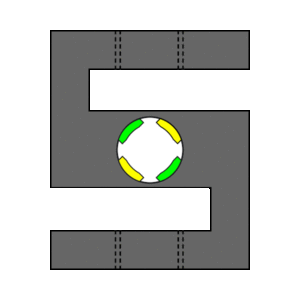
Bending Beams
Bending beam load cells incorporate strain gauges that are bonded on the flat upper and lower sections of the load cell at points of maximum strain. These types of sensors are often used in multiple force sensor applications, including tank or vessel weighing and industrial process control systems. Bending beams have a low-profile design for easy integration into restricted spaces. These types of cells are often used for low-capacity applications and perform with excellent linearity. One drawback of this design is that it must be loaded correctly to obtain consistent results.
Shear Beams
In this design, to maximise the shear effect, the strain gauges are bonded to a reduced part of the beam’s cross-section. The strain gauges are bonded at 45 degrees on either side of the beam to measure the shear strains. Used for medium-to-large capacities, the force sensor has good linearity and is not as susceptible to extraneous loading, in particular to side loads.
Pancake Load Cells
The popular pancake-type load cell is configured to operate in shear, offering a shallow profile in a design that is easily environmentally sealed and is largely insensitive to off-axis loads.

For high-reliability applications, the pancake-style sensor also easily accommodates dual, electrically separated strain bridges. The high stiffness tension-base enables the measurement of tensile forces, which stiffens the structure in compression and allows the incorporation of over-range limiting stops for compression applications.
Platform and Single Point Load Cells (Dual Beam)
This type of force sensor is used in commercial and industrial weighing systems. Thanks to their dual cantilever design, they are insensitive to bending moments providing high-accuracy readings and stability, regardless of the position of the load on the platform.
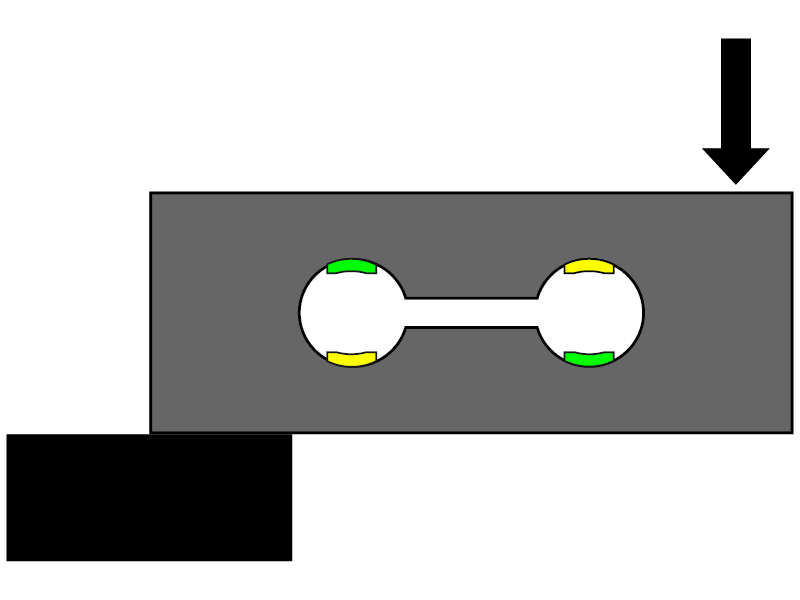
Canister Load Cells
Canister sensors are used for single and multiple weighing applications. Many canister designs incorporate an all-stainless steel construction and are hermetically sealed to withstand frequent wash-down or damp/wet conditions.
Low Profile Force Sensors
Low-profile force sensors can be compression or tension/compression type designs. Mounting holes and female threads are provided for easy installation. These types are often used in weighing research and development activities and for inline force monitoring.
Often, low profile multiple-bending designs incorporate four spokes at 90-degree intervals, where strain gauges are wired to cancel out off-axis moment-induced strains.
Miniature Load Cells
Due to their compact size, miniature versions normally use semiconductor strain gauges as the sensing element. The designs come in many different configurations for both tension and compression force measurement. Miniature force sensors offer good performance with high outputs and high overload capability for protection.
Load Cell Applications
Potential applications include the weighing of silos, vessels, crane safety monitoring, weighing of tanks, vessels and conveyors, lifting, fatigue testing, R&D testing, quality control, industrial weighing scales, weigh platforms, Weighbridges, Underhook scales, tensile testing machines and dynamometers. The marine sector also uses waterproof, submersible or seawater load cells.
Other force sensor designs include special, custom-designed cells, including battery-powered versions, aluminium or stainless steel, robust outdoor weatherproof units, universal, multi-axis versions and waterproof or submersible load cell designs.
Looking After Your Load Cell
Load cells are very delicate instruments and need correct handling and care to avoid costly repairs. Below are a few of Applied Measurements key ways to help maintain your sensor:
- Always choose the correct type of sensor for your application
- Use the load cell within the specified capacity/range to avoid overloading the load cell
- Consider the environment it will be used in and check whether it is suitable for that environment.
- The load cell should be calibrated to UKAS traceable standards to ensure correct measurement results
- Always use it within the specified operating temperature and store it within the storage temperature as specified on the datasheet.
- Correct installation is key to good results. Make sure it is installed on flat, clean surfaces for optimum measurements.
Interested in our load and force measurement products? Let us call you…
Why Choose Applied Measurements?
- Applied Measurements supply top quality strain gauge sensors and transducers to every corner of industry – UK and worldwide
- Over 100 years of expert transducer knowledge
- Applied Measurements high-quality products all come with a 3-year warranty


